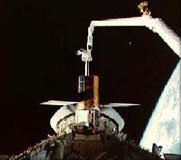

- The Canadarm can be used for launching or retrieving satellites (satellites can also be launched using rockets)
- So that the Canadarm can grip these satellites, they are built with a part called a grapple fixture, which is attached to the bus of the satellite
- The original grapple fixture consisted of a foot-long metal pin, a baseplate, and a target
- The end of the Canadarm (called its End Effector) has three snare wires which wrap around the grapple fixture using small motors
- The wires are then retracted, and the satellite is pulled snugly against the end of the Canadarm
- Today, grapple fixtures have removable grapple pins so that if the Canadarm fails, an astronaut can manually remove the pin to release the satellite
- Grapple fixtures now have an electrical connector on the end of the pin
- This can join with an electrical adaptor (called a Special Purpose End Effector or SPEE) at the end of the Canadarm
- This allows electrical power and data communications to move from the shuttle to the satellite when it is grappled
- This is used to preserve a satellite's batteries during deploy and retrieval activities
- The Canadarm is unable to grasp older satellites, or satellites not expected to be repaired in orbit, because they were not fitted with grapple fixtures when they were originally launched
- The Canadarm can also only capture satellites which are in the same orbital path as the shuttle (for example, the shuttle never flies in a polar orbit)
Home | Types & Uses | Anatomy of a Satellite | Canadian Satellite Q&A
You Be the Engineer | Image Gallery | Glossary | Credits
Produced by Galactics.
Comments: galactics@spacesim.org.
Last updated on: 8 August 1997.
![]()